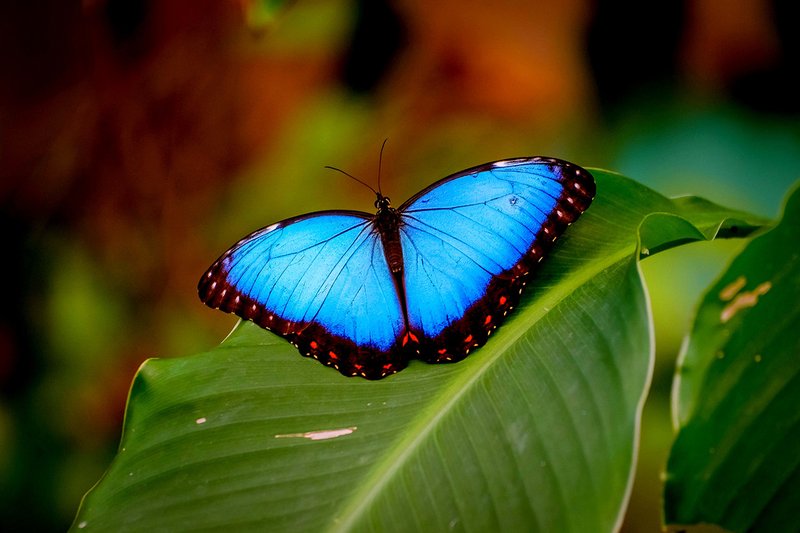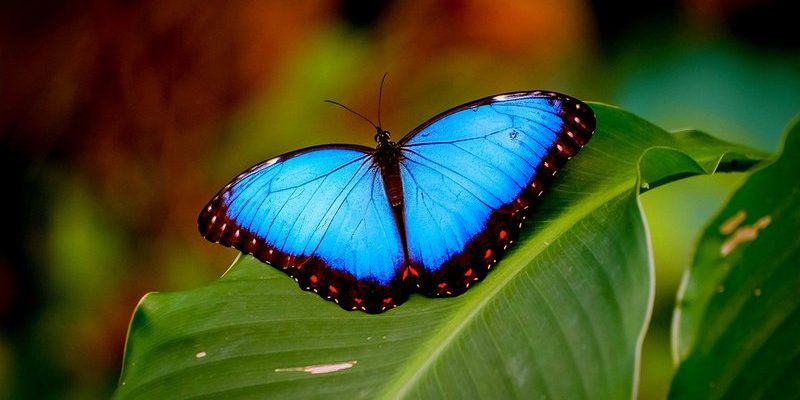
Imagine a creature that glides effortlessly through the air, its wings shimmering with iridescent blue hues that catch the sunlight like a jewel. This isn’t just any butterfly; it’s the Blue Morpho Butterfly, one of the most breathtaking insects on the planet. With a wingspan that can reach up to six inches, this butterfly is not just beautiful, but also plays an important role in its ecosystem.
You might be curious about what makes the Blue Morpho so special. After all, with thousands of butterfly species fluttering around, what sets this one apart? From its vibrant color to fascinating behaviors, the Blue Morpho is a true wonder of nature. Let’s take a closer look at its life cycle, habitat, diet, and much more.
Physical Characteristics
The Blue Morpho Butterfly stands out due to its stunning coloration. As adults, their wings are primarily a brilliant sky-blue, which serves a vital purpose: it helps them evade predators. The underside of their wings is brown, spotted with eyespots that blend into the forest floor, further protecting them when they are at rest. This combination of colors is not just for aesthetics; it’s a clever survival tactic.
Measuring between 5 to 6 inches, the wingspan of the Blue Morpho is quite impressive. Their large wings allow them to fly gracefully in search of food and mates. When flying, their wings create a soft fluttering sound, which adds to their enchanting presence in the tropical rainforests they inhabit. The males are typically more vibrant than the females; their intense blue color signals to potential mates that they are healthy and strong.
Did you know that the Blue Morpho’s wings are not actually colored blue? Instead, their wings contain microscopic scales that reflect light in a way that creates the illusion of a rich blue color. This phenomenon is known as structural coloration and is a beautiful reminder of nature’s complexity.
Habitat and Distribution
The Blue Morpho Butterfly primarily inhabits the lush rainforests of Central and South America. From the Amazon Basin to the forests of Costa Rica and Mexico, these butterflies thrive in areas with plenty of understory vegetation. They prefer warm, humid environments where flowers bloom year-round, providing a continuous food source.
These butterflies are most commonly found at altitudes between 500 to 1,500 meters. The dense canopy of the rainforest is critical for their survival, offering protection from predators and harsh weather. Interestingly, the Blue Morpho is often seen near water sources where they sip moisture from the ground or nearby puddles. It’s a simple act, but it’s crucial for their hydration.
In terms of conservation, the Blue Morpho Butterfly is not currently endangered, but habitat destruction poses a significant threat. Logging, agricultural expansion, and urban development can lead to a decrease in their populations. Protecting their rainforest homes is essential for ensuring that future generations can enjoy the sight of these magnificent butterflies.
Feeding Habits
The diet of the Blue Morpho Butterfly is primarily nectar-based. They are particularly attracted to flowering plants, where they sip nectar using their long proboscis—a tube-like tongue designed for such tasks. You might spot them hovering around non-native flowers as well, but their favorites are typically local plants, especially those that produce sweet nectar.
Interestingly, Blue Morphos also rely on other food sources. They have been observed feeding on rotting fruit and tree sap, which provide additional nutrients. This adaptability is quite fascinating; it shows how these butterflies can thrive in various conditions by making the most of what is available. When looking for food, they flutter from flower to flower, and their bright colors make them easy to spot even from a distance.
Adult butterflies require a diet rich in sugars to fuel their high-energy lifestyle. They use their keen eyesight to identify sources of food and are particularly drawn to bright colors. It’s almost as if they have a sixth sense when it comes to locating the tastiest nectar!
Life Cycle
The life cycle of the Blue Morpho Butterfly is quite remarkable and consists of four distinct stages: egg, larva (caterpillar), pupa (chrysalis), and adult butterfly. The entire process can take anywhere from a few weeks to several months, depending on environmental conditions. Let’s break it down:
Firstly, female Blue Morphos lay up to 100 eggs on the underside of leaves, usually close to their host plants. Once the eggs hatch, the caterpillars emerge. These caterpillars are striking in their own right—often green with spiny projections, allowing them to blend in with the foliage. They feast on leaves, growing rapidly as they prepare for the next stage.
After feeding for several weeks, the caterpillars enter the pupal stage. Here, they form a chrysalis that is usually camouflaged among the leaves. This is a critical period for transformation as the caterpillar undergoes metamorphosis to emerge as a stunning Blue Morpho Butterfly. The transformation can take anywhere from 10 days to two weeks, after which they break free and begin their new life.
Behavior and Adaptations
The Blue Morpho Butterfly exhibits several fascinating behaviors. For one, their unique flight patterns make them appear almost like a flash of blue light darting through the trees. They are known for their strong, swift flapping, which helps them evade predators in the dense canopy. This skillful maneuvering is a crucial adaptation for survival.
Mating rituals of the Blue Morpho are also interesting. Males often engage in a dance-like display, fluttering their wings to showcase their vibrant colors to potential female partners. This display not only attracts females but also establishes territory among competing males. It’s a dance of both elegance and competition.
Another notable behavior is their tendency to bask in the sun. Blue Morphos will often perch on leaves, spreading their wings wide to absorb warmth. This behavior helps regulate their body temperature, especially in the cooler mornings or after rain, allowing them to become active and flight-ready.
Threats and Conservation Efforts
Despite being a thriving species, the Blue Morpho Butterfly faces threats primarily from habitat loss due to deforestation and climate change. Their dependence on specific habitats makes them vulnerable to changes in the environment. As rainforests continue to be cut down for agriculture and urban development, these butterflies lose both their homes and food sources.
Conservation efforts are underway to protect the natural habitats of the Blue Morpho. Organizations are working to promote sustainable forestry practices and establish protected areas where these butterflies can thrive. Educating local communities about the importance of biodiversity is crucial for ensuring the survival of the Blue Morpho and countless other species that share its habitat.
Additionally, research into butterfly populations is essential for monitoring their health and numbers. Citizen scientists and enthusiasts contribute greatly by documenting sightings, which helps conservationists understand where populations are thriving and where they need protection the most.
Interesting Facts
The Blue Morpho Butterfly is surrounded by fascinating facts that enhance its allure. For instance, did you know that their wings are also used in traditional crafts? The striking colors and patterns make their wings a popular choice for jewelry and art, particularly in areas where they are found.
Another interesting aspect is that Blue Morphos can live for several months in their adult stage, while their earlier stages last only a few weeks. This longevity allows them to reproduce multiple times during their lifetime, contributing to the vitality of their population.
Finally, their vibrant colors can also send signals beyond attraction. When threatened, the Blue Morpho can suddenly close its wings, exposing its dull undersides, effectively surprising predators and allowing a chance for escape. Isn’t nature clever?
Table of Blue Morpho Butterfly Facts
| Wingspan: | 5 to 6 inches |
| Habitat: | Tropical rainforests of Central and South America |
| Diet: | Nectar, rotting fruit, tree sap |
| Lifespan: | Up to 5 months (adult stage) |
| Metamorphosis Duration: | 2 weeks (pupa stage) |
FAQ
What do Blue Morpho Butterflies eat besides nectar?
In addition to nectar, Blue Morpho Butterflies are known to feed on rotting fruit and tree sap. These food sources provide essential nutrients and sugars, helping the butterflies maintain their energy levels. This flexibility in diet allows them to thrive in various environments where food sources may vary.
Are Blue Morpho Butterflies endangered?
Currently, the Blue Morpho Butterfly is not considered endangered. However, habitat loss due to deforestation and climate change poses a significant threat to their populations. Conservation efforts are crucial to ensure their habitats are protected, allowing these beautiful butterflies to continue flourishing in the wild.
What do Blue Morpho Butterflies symbolize?
In many cultures, butterflies, including the Blue Morpho, symbolize transformation, beauty, and freedom. Their stunning colors and life cycle from caterpillar to butterfly resonate with themes of growth and change. The Blue Morpho’s vibrant presence particularly represents hope and renewal in the natural world.
How can we help protect Blue Morpho Butterflies?
One of the best ways to help protect Blue Morpho Butterflies is by supporting conservation efforts that focus on preserving tropical rainforests. This can be done through donations to wildlife organizations or participating in community efforts to promote sustainable practices. Additionally, advocating for responsible consumer choices can make a significant impact on reducing habitat destruction.
How long does the Blue Morpho Butterfly live?
In its adult stage, the Blue Morpho Butterfly can live for up to five months. This lifespan may vary depending on environmental conditions and predation rates. Their ability to reproduce multiple times during their lifetime contributes to the resilience of their population.
How do Blue Morpho Butterflies avoid predators?
Blue Morpho Butterflies use a combination of their vibrant colors and flight patterns to evade predators. Their striking blue wings can startle potential threats, while their ability to blend into the forest floor when at rest helps them avoid detection. This clever use of camouflage and surprise aids in their survival.
Can Blue Morpho Butterflies be kept as pets?
While it is possible to keep Blue Morpho Butterflies in captivity for educational purposes or butterfly gardens, they require specific environmental conditions to thrive. This includes maintaining warm temperatures and providing access to suitable food sources. It’s important to ensure that their needs are met, as their well-being can be challenging to maintain outside their natural habitat.
Do Blue Morpho Butterflies migrate?
Unlike some butterfly species, Blue Morpho Butterflies do not migrate long distances. They typically remain within their home range, which is marked by the availability of food and suitable mating conditions. However, local movements can occur as they search for food and mates within their rainforest habitats.
What are the predators of the Blue Morpho Butterfly?
The Blue Morpho Butterfly faces threats from various predators, including birds, spiders, and other larger insects. Their remarkable wing patterns and colors help them evade these predators, but they are still vulnerable, especially in their earlier life stages as caterpillars. The eyespots on the underside of their wings also serve as a defense mechanism, deterring would-be attackers.
How do Blue Morpho Butterflies reproduce?
Reproduction in Blue Morpho Butterflies involves a complex courtship process. Males engage in displays to attract females, showcasing their vibrant wing colors. After mating, females lay eggs on specific host plants, ensuring that the caterpillars have access to food once they hatch. This careful selection is crucial for the survival of the next generation.

